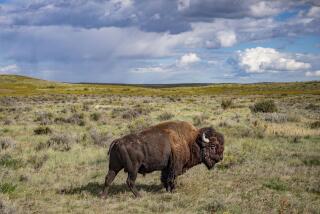The ‘Eagle’ Has Landed : PBS’ Eight-Hour Special Re-creates Settling of North America
- Share via
George Page, the host, narrator and executive editor of PBS’ “Nature” series, felt a sense of hope for Northern America’s future while working on “Land of the Eagle.”
The special eight-hour edition of “Nature” chronicles the natural history of North America, examining the continent’s world by setting it against the drama of the early Europeans who explored, settled, developed and often ravaged the land. The special also looks at what the Europeans’ arrival meant to Native Americans.
“It was something of a miracle we were able to film this and re-create a sense of what it was like 400 years ago,” Page said. “There is enough of the natural world left that the film crews could actually film without modern structures in the background, and there was enough to make eight hours of television re-creating what it must have been like.”
Most PBS stations will be airing two one-hour episodes of “Land of the Eagle” each evening, beginning tonight through Wednesday, and then will repeat all eight hours Thanksgiving Day.
The first two hours look at the challenges and defeats of the first English colonists and at how the French settlers set up trading businesses with the Huron nation and other Native Americans in Canada.
Subsequent episodes will follow the arrival of the Spanish conquistadors in Florida, travel across the Great Plains, climb to the snow-covered peaks of the Rocky Mountains, encounter the desert region of the Southwest, explore California’s past and current environmental challenges and visit Alaska, the continent’s last pristine wilderness.
The majestic bald eagle, a familiar sight to those early European settlers and a sacred symbol to the Native Americans, is the connecting thread between each episode.
“I think this series is going to have an impact,” Page said. “I don’t think the majority of Americans know the real history of how this country was explored and the reality of the Native Americans being here. It was not a pristine wilderness, which the Europeans thought it was, but a place where people lived and farmed and worked and who had, in many cases, very high cultures.”
Executive producer Peter Crawford spent four years working on “Land of the Eagle” for the BBC, which co-produced the project and aired it last year. He worked with a team of four producers, each tackling a different part of the continent.
The motto on crew members’ sweatshirts was, “You should have been here yesterday.”
“The animals always would do what you wanted them to do yesterday,” Crawford said. “The weather was always better yesterday. You find that’s inevitable in all wildlife filming. It’s an outdoor job and you can’t control it. The animals don’t read the script.”
In one segment, there’s a magnificent sequence in which two bighorn male sheep bang their horns together while mating. Crawford said the episode’s producer, Ned Kelly, and his cinematographer, Bruce Reitherman, explored the summits of the Rockies during winter to find bighorn sheep. After two weeks of searching, the two returned to their hotel.
“Would you believe that sequence was filmed within a half-mile of their hotel?” Crawford said. “In fact, if the camera panned very slightly to the right, I think you could have seen the highway and telegraph wires. These animals just turned up at the 11th hour and performed right in front of them.”
“Land of the Eagle” was a critical and audience hit when it premiered last year in England. The U.S. version is different.
“The sensibilities of the two audiences are quite different,” Page said. “We did a lot of work on the scripts and we added some new segments, mostly relating to the social history and the Native Americans.”
Page said he hopes the series will be controversial. “We will probably get accused of political correctness and bending over backwards to make the Native American point of view heard throughout the series.”
However, Dr. Alfonso Ortiz, professor of anthropology at the University of New Mexico who was the show’s Native American adviser (he’s a Pueblo Indian), said the Native American point of view wasn’t fairly represented.
“Beetles and lizards got more attention than the indigenous human cultures of the various areas,” he said. “In the California episode, there are no photographs or even realistic sketches (of Native Americans)--nothing but shadowy, invisible figures where references are made to California Indians.
“For American audiences to be duped or to be lead to think this was a continent empty and devoid of human life and a playground for grizzly bears, whales, buffalo and eagles, it (series) is self-serving,” Ortiz said. “It justifies the whole insane process of the European invasion. That is what troubles me deeply about the series. I am not one of your politically correct thinkers, all I am asking for is correction, to own up to the history that did take place.”
Crawford disagreed. “It was my idea to make sure we had an American Indian perspective, which got away from the romanticized noble savage concept of the American Indian,” he said. “Although I wouldn’t pretend we have been 100% successful, I think we made a very intelligent and creative attempt.”
“Land of the Eagle” airs tonight-Wednesday from 7 to 9 p.m. on KVCR a n d 8 to 10 p.m. on KCET and KPBS. All eight hours are repeated Thursday at 10 a.m. on KCET and Dec. 1 at 10 a.m. on KPBS.
More to Read
The complete guide to home viewing
Get Screen Gab for everything about the TV shows and streaming movies everyone’s talking about.
You may occasionally receive promotional content from the Los Angeles Times.







